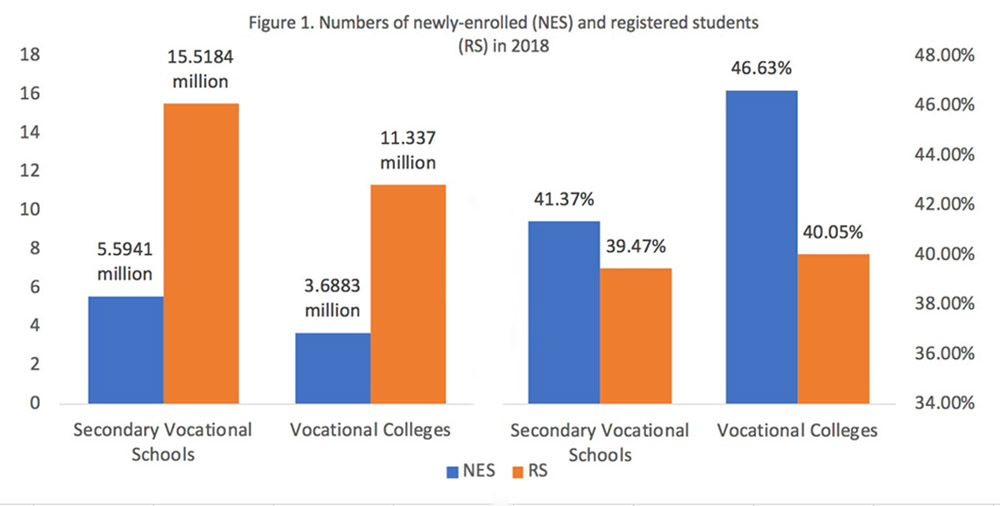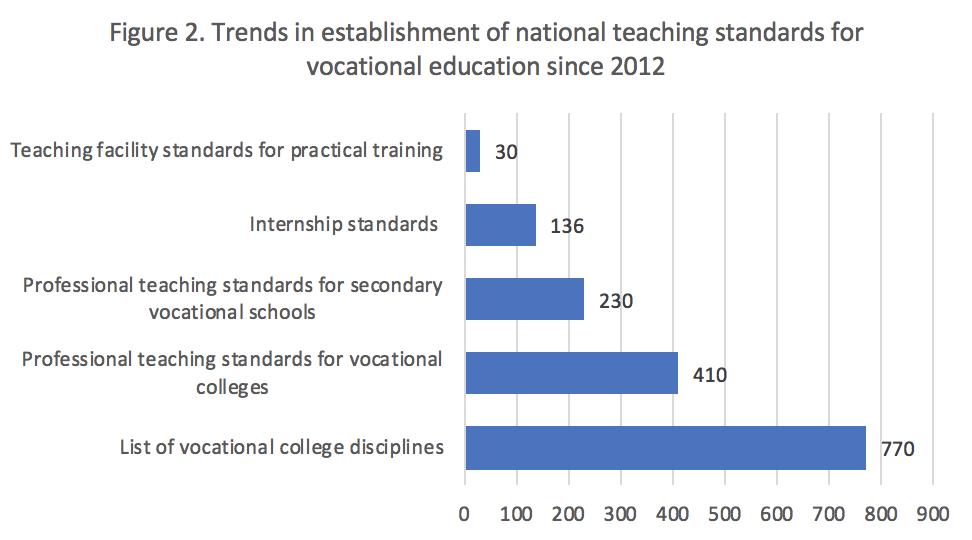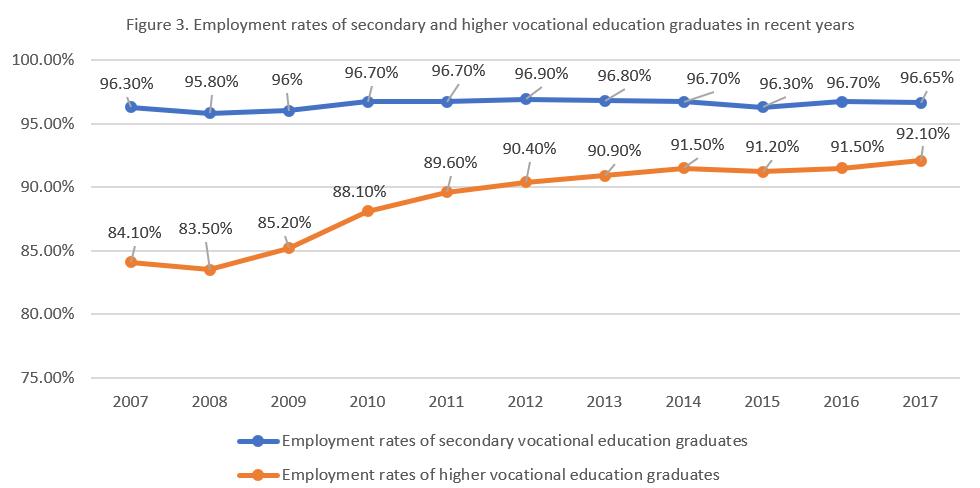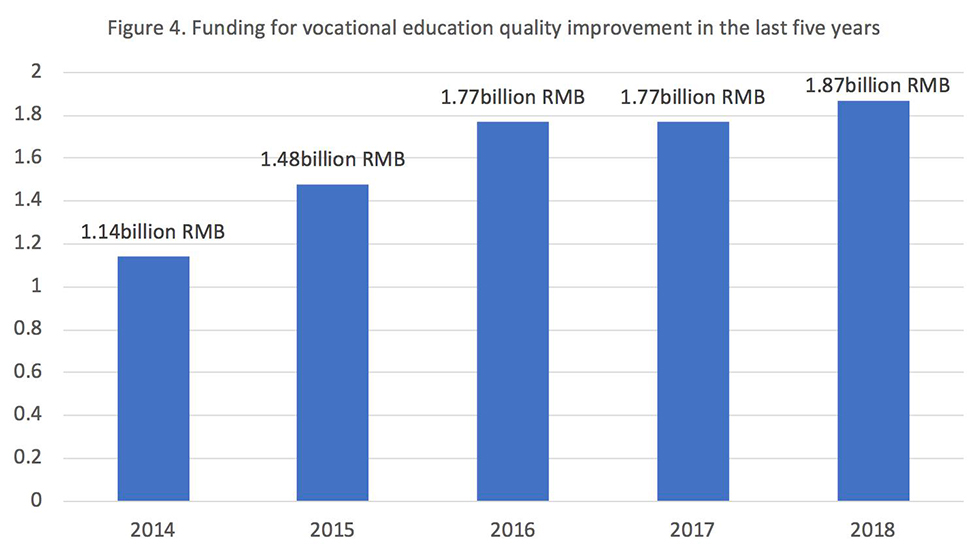In the light of the goal set out during the 18th CPC National Congress in 2012, and in line with relevant Central Government decisions and policies, the MOE has pursued the development of vocational education as a way to facilitate national development and boost employment, following a path with unique Chinese characteristics, and making unprecedented progress in various areas.
First, China now has the world’s largest vocational education system. In 2018, there were a total of 11,700 vocational education institutions in the country, including 10,300 secondary vocational schools1 and 1,418 vocational colleges, with 9.2824 million newly-enrolled students and 26.8554 million registered students. More specifically, secondary vocational schools had 5.5941 million newly-enrolled students and 15.5184 million registered students, representing 41.37% and 39.47% of the total students in these two categories in secondary education2 respectively; while vocational colleges had 3.6883 million newly-enrolled students and 11.3370 million registered students, representing 46.63% and 40.05% of all students in these two categories in higher education respectively. These institutions provide extensive training, benefiting hundreds of millions of people every year. In sum, the sector has developed adequate capacity for large-scale training of technicians and skillful workers, serving as an essential lever for the country’s economic and social development in terms of human resources.

Second, remarkable progress has been achieved in promoting cooperation between vocational training providers and companies. A total of 56 vocational education steering committees have been established, pooling over 3,000 experts from different industries to provide guidance on vocational education from an industrial perspective. 1,400 vocational education groups have been set up, attracting more than 30,000 companies to jointly explore cooperative training mechanisms, such as customized training, “factories in schools” or “schools in factories”, modern apprenticeship, etc. With input from industries and companies, an updated list of vocational college disciplines (770 in total) has been published and a range of standards have been drawn up, including 410 professional teaching standards for vocational colleges, 230 professional teaching standards for secondary vocational schools, 136 internship standards for vocational education institutions, and 30 teaching facility standards for practical training in vocational education institutions.

Third, vocational education has made greater contribution to economic and social development by building human capital. The employment rate of secondary vocational school graduates has stood at over 95% for 10 consecutive years, and the rate for vocational college graduates six months after their graduation has exceeded 90% in recent years. In 2018, nearly 70% of vocational education graduates found jobs in counties and cities near their schools; and over 70% of those entering the workforce in modern manufacturing and emerging industries graduated from vocational education institutions. Vocational education graduates have become a new force for facilitating the development of SME clusters or networks and catapulting regional industries to the upper end of the value chain. In addition, China has cooperated with various developing countries and international organizations in providing training services and support to school construction projects in these countries and sharing its own experiences in vocational education development.

Fourth, vocational education has played an increasing role in creating equity and supporting poverty eradication. China has implemented a number of vocational education promotion projects, such as building demonstrative secondary and higher vocational education institutions, improving vocational education quality and facilitating industry-education integration, which have witnessed the emergence of a wide array of high-performing schools, strong disciplines and high-caliber teacher workforce. In 2017, government funding for vocational education across the country reached 335 billion RMB. The student aid system targeting students from low income families has been improved, providing tuition exemption and grants to 90% and 40% of secondary vocational students respectively and offering scholarships and grants to 30% and 25% of vocational college students respectively. Over the past three years, thanks to the rapid development of vocational education, 8.5 million families have for the first time in their family history realized their dream of sending their children to college. Meanwhile, an East-West regional cooperation plan has been implemented to provide vocational training to farmers, rural migrant workers, laid-off workers, the unemployed and people with disabilities, making a significant contribution to the country’s achievement in poverty relief over recent years, i.e. lifting over 10 million people out of poverty on average every year.

Fifth, a number of national vocational education events have been organized, building a more favorable environment for vocational education. Since 2015, ‘Vocational Education Week’ events have been conducted every year to raise public awareness about the role of vocational education. The MOE has organized the National Vocational Student Skills Competition for 11 consecutive years, whose national finals have been attended by more than 60,000 students over the past five years cumulatively. The ministry has held national secondary vocational school student talent shows for 13 consecutive years, which attracted 3.921million students in 2018. It has also released annual higher vocational education quality reports and national reports on job placement of secondary vocational schools on a regular basis.

Note:
1. Secondary vocational schools include regular and adult specialized secondary schools, vocational high schools and technical schools.
2. Secondary education institutions include regular and adult high schools and secondary vocational schools.



